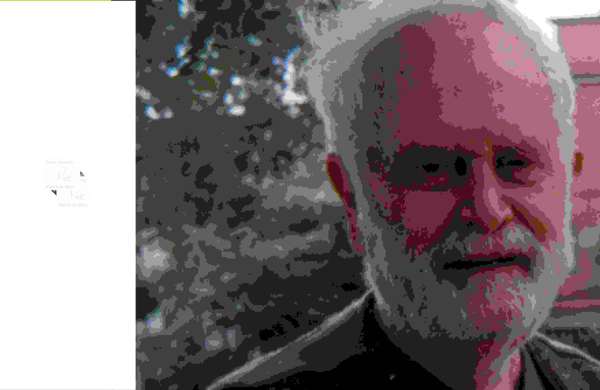|
Patrick de Maré my master (maestro) and friend Rocco Pisani In the eighties after I had completed my training in Group Analysis, I devoted myself to reading S. H. Foulkes' works and translating them into Italian. I was fascinated by this figure and my greatest regret was that I did not have time to meet him in person before his death. Translating "Introduction to Groupanalytic Psychotherapy" into Italian, I found Patrick de Maré cited many times and his contribution to group analysis through his conduction of many groups. As an alternative to Foulkes I decided to meet Patrick. The opportunity came during a winter workshop in London. In fact I was telling Brenda Ling, then secretary of the Group Analytic Society, how sorry I was that I had not been able to meet Foulkes and of my desire to meet at least Pat, when at that very moment the door opened and Pat entered. Brenda immediately seized the opportunity and introduced me. I was struck by his profound humanity. Reading his writings had made me idealise him and instead I found myself before a simple, genuine person, rich in culture, humour and kindly irony, all in all a real gentleman. In 1985 the 9th Foulkes Annual Lecture was given by Pat. He spoke very little and transformed the lecture into a very successful large group in which more than 300 people participated. The group was conducted along Foulkensian lines and in some way I had an opportunity to see also Foulkes in action. I began a very profound dialogue with him on group analysis, his development and his personal and original contribution. A dialogue consisting of meetings, postal correspondence, phone calls and sincere friendship. I have kept nearly all the letters that Pat sent me over the years. On the occasion of another meeting in London, he invited me, together with some other colleagues, to an Indian restaurant; he called the waiter and got him to bring us a long Indian knife. In a jovial atmosphere he nominated me "Knight of the Round Table"...! Continuing to associate with him I had an opportunity to participate in median groups led by him in Amsterdam, Melbourne and Gothenburg. In 1998 in London Pat split a large group into three median groups and I had the honour of conducting one of the three. The other was entrusted to Siv Anderson. In 1991 we presented the Italian edition of "Introduction to Groupanalytic Psychotherapy" in Rome. Pat and Elizabeth Foulkes came. Both participated in a median group session which I had just started in the Outpatients Department of the Department of Neurological Sciences of the University of Rome. At the end of the session Pat commented: "Rocco, I would like to be treated in this group!" Obviously it was a comment as a gentleman, but it gave me great pleasure. The meeting ended with a wonderful party at the home of Maria Antonia Ferrante and Jaime Ondarza Linares, who had been my trainer in group analysis. To everyone's great delight, Pat played the accordion. The meeting was filmed and converted to DVD, a copy of which I gave to Pat and Turid on the occasion of a recent visit. We met and worked together many times. In Italy we organised meetings and workshops in Rome, Aprilia, Sassari, Brindisi and Bolzano. In 1996 we launched the Italian edition of "Koinonia". My book "Elementi di Gruppoanalisi" was published in the year 2000. In the foreword Pat wrote: "I feel honoured to have been asked to write a foreword by my friend and colleague Prof. Rocco Pisani to his great work ‘Elementi di Gruppoanalisi'. This is the first ever of a serious attempt to include the Median Group as a significant feature in group analysis and introduces the enormous importance which the role that culture and context play in influencing the outcome of failure or success in psychotherapy". From 1991 to 2003 I conducted the median group, with weekly sessions, in the Outpatients Department of the Department of Neurological Sciences of the University of Rome. The sessions were recorded and transcribed by my co-workers and have been gathered together in 19 volumes, at present kept in my private practice. Pat saw this huge work and was very pleased with it. Our last meeting goes back to 9 December 2006. My wife Nina, Inger Larsson, Tove Mathlesen, Bernard Saint, Ingo Stermann and I went to visit him. In an atmosphere rich of humor Nina was nominated the first Dame of the Round Table, followed by Inger and Tove. Bernard and Ingo were nominated the new Knights..! Dorothy Brown joined us later and we had an Indian dinner with him and Turid at his home. He was tired but perfectly lucid. He gave us with dedication a copy of "The history of large group phenomena in relation to group analytic psychotherapy", which began with a summary of the history of the Knights of the Round Table by Marcel Mauss.
The Median Group constitutes the most important development of Foulkes' ideas applied to a wider group context. To this de Maré has given an absolutely personal and original imprint. In the last part of his book: "Perspectives in Group Psychotherapy" (1972) de Maré concludes that not only the outcome of a neurosis, but the destiny of our entire civilisation necessarily depends on the ability to rise to unity and achieve fellowship or Koinonia.  |